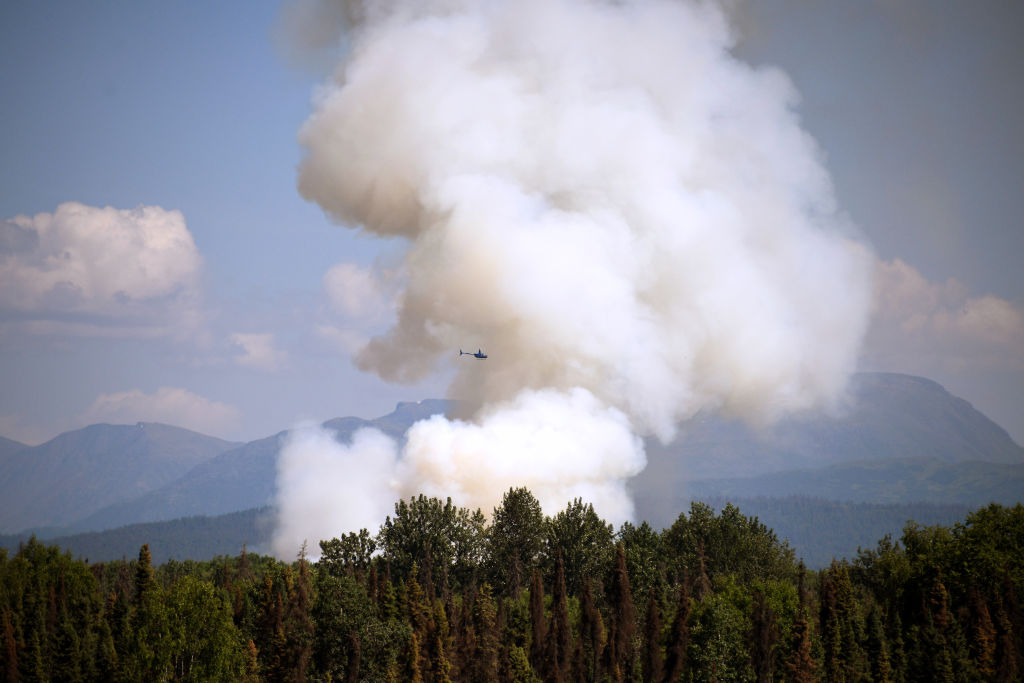
Wildfires are a normal part of life in Alaskan forests. While the state is experiencing an “extreme” fire season this year, with over 2.5 million acres burned, the size of the fires is still well short of the record set in 2004 – 6.5 million acres.
But what’s worrisome, says Beth Ipsen of the Alaska Interagency Fire Information Office, is just how long this fire season has stretched on. The season started early, beginning on April 30 with the Oregon Lakes Fire. And while fires typically start to peter out in August, recently there’s been a major uptick. About 236 of the 663 fires that started this year are still burning in the state, and it’s not clear when they’ll start to fizzle out.
“This is not normal,” Ipsen tells TIME.
Record-breaking temperatures and dried-out vegetation has set the stage for major fires in much of central and southern Alaska this summer, scientists say. And while fire experts say that wildfires are a normal part of the life cycle of the state’s boreal landscape, major fire seasons seem to be more common – and to be stretching longer. For many Alaskans, the end of the fire season couldn’t come soon enough; many are coping with severe smoke conditions, and at least 50 structures were destroyed last weekend in the McKinley Fire in southern Alaska.
Scientists say that it’s likely that climate change not only plays a major part in causing the fires, but that the carbon being released as smoke might be making the warming effect worse.
This summer, Alaska cities and towns recorded some of their hottest temperatures on record. Anchorage experienced its first temperature above 90 degrees Fahrenheit. Scott Rupp, deputy director of the International Arctic Research Center at the University of Alaska- Fairbanks, says that part of the problem is that places closer to the poles are warming faster than the rest of the world.
Alaska is warming at about 2.5 times the rate of the lower 48 states, partly because when snow and ice melts, it leaves behind darker snow and water, Rupp says. In recent years, the start of the part the year without any snow has started about two weeks earlier in Alaska.
The number of major fire years, in which more than a million acres burned, has also increased in Alaska, says Rupp. Although there were only eight major fire years from 1950 to 1989, from 1990 to 2018 there were 11 years in which more than a million acres burned.
Fire seasons that see the burning of a million acres are not unusual, says Rupp, but “What has been changing is the frequency and the magnitude of these fires.”
Peter Bieniek, a research associate professor International Arctic Research Center at the University of Alaska-Fairbanks, tells TIME that a warmer, moister climate may also generate more fires caused by lightning strikes.
Lightning sparks the majority of fires in Alaska. It caused about 361 of the total of 663 fires this year (about 291 of the rest are believed to have been caused by humans), according to Ipsen.
Bieniek says that in his most recent research, he’s found that thunderstorms are becoming more common in Alaska, and that the number of lightning strikes is expected to double by 2100.
“You get more warmer temperatures, more moist conditions – that’s kind of key recipe for making thunderstorms,” Bieniek says.
Rupp says that agrees that there’s a likelihood that thunderstorms are getting worse. Unfortunately, he says, the fires themselves are creating a “positive feedback loop for the environment. Not only are the conditions for severe fire seasons becoming more common, but major fires pump greenhouse gases into the environment. Boreal forests are usually a “carbon sink” that absorbs carbon, but when they burn too frequently they can become a “carbon source.”
“We’re increasing greenhouse gases, which leads to more warming, which leads to more fires,” Rupp says.
Correction, Aug. 22
The original version of this story misstated the year during which Alaska experienced its most severe wildfires. Alaska had its most severe wildfires in 2004, when 6.5 million acres burned. 2015 was Alaska’s second-most destructive year, with 5.1 million acres burned.
More Must-Reads from TIME
- Cybersecurity Experts Are Sounding the Alarm on DOGE
- Meet the 2025 Women of the Year
- The Harsh Truth About Disability Inclusion
- Why Do More Young Adults Have Cancer?
- Colman Domingo Leads With Radical Love
- How to Get Better at Doing Things Alone
- Michelle Zauner Stares Down the Darkness
Contact us at letters@time.com